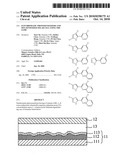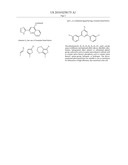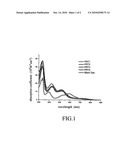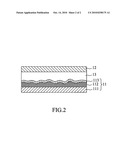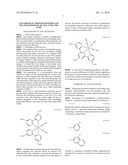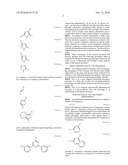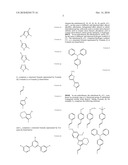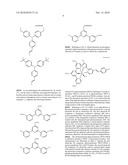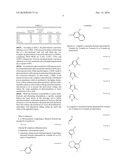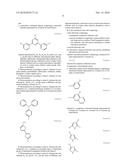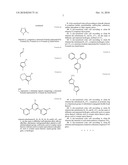Patent application title: PANCHROMATIC PHOTOSENSITIZERS AND DYE-SENSITIZED SOLAR CELL USING THE SAME
Inventors:
Yun Chi (Hsinchu, TW)
Yun Chi (Hsinchu, TW)
Kellen Chen (Hsinchu, TW)
Yi-Huan Hong (Hsinchu, TW)
Pi-Tai Chou (Taipei, TW)
Pi-Tai Chou (Taipei, TW)
Bo-So Chen (Taipei, TW)
Hui-Chu Hsu (Hsinchu, TW)
IPC8 Class: AH01L3100FI
USPC Class:
136256
Class name: Photoelectric cells contact, coating, or surface geometry
Publication date: 2010-10-14
Patent application number: 20100258175
zers having a Formula of ML1L2X were
synthesized, wherein M comprises ruthenium atom; X is a monodentate
anion; L1 is heterocyclic bidentate ligand having one of formulae
listed below:
##STR00001## wherein G2 has one of formulae listed below:
##STR00002## and L2 is a tridentate ligand having a formula
listed below:
##STR00003##
The substituents R1, R2, R3, R4, R5, R6,
R7 of L1 and L2 are the same or different, and represent
alkyl, alkoxy, alkylthio, alkylamino, halogenated alkyl, phenyl or
substituted phenyl group, carboxylic acid or counter anion thereof,
sulfonic acid or counter anion thereof, phosphoric acid or counter anion
thereof, amino-group, halogens, or hydrogen. The above-mentioned
photosensitizers are suitable to use as sensitizers for fabrication of
high efficiency dye-sensitized solar cell.Claims:
1. A Photosensitizer comprising a chemical formula represented by Formula
(a):ML1L2X Formula (a)wherein M comprises ruthenium atom;X
represents a monodentate anion;L1 represents a heterocyclic
bidentate ligand, comprising a structural formula represented by Formula
(b) or Formula (c) listed below: ##STR00018## wherein G1 comprises a
structural formula represented by Formula (d), Formula (e), Formula (f)
or Formula (g) listed below: ##STR00019## G2 comprises a structural
formula represented by Formula (h), Formula (i) or Formula (j) listed
below: ##STR00020## andL2 represents a tridentate ligand, comprising
a structural formula represented by Formula (k) listed below:
##STR00021## wherein substituents R1, R2, R3, R4,
R5, R6 and R7 of L1 and L2 are the same or
different, and represent alkyl, alkoxy, alkylthio, alkylamino,
halogenated alkyl, phenyl or substituted phenyl group, carboxylic acid or
counter anion thereof, sulfonic acid or counter anion thereof, phosphoric
acid or counter anion thereof, amino-group, halogens, or hydrogen.
2. Photosensitizers according to claim 1, wherein X comprises halide, pseudohalide, carboxylate, carbanion, sulfate, phosphate or other organic anion.
3. Photosensitizers according to claim 1, wherein X comprises thiocyanate.
4. Photosensitizers according to claim 1, wherein the substituents R1 and R3 of L1 are the same or different, and represent hydrogen, isobutyl or CF.sub.3.
5. Photosensitizers according to claim 1, wherein the substituent R2 of L1 comprises hydrogen, isobutyl, CF3 or a structure formula represented by Formula (l) or Formula (m) listed below: ##STR00022##
6. Photosensitizers according to claim 1, wherein the substituent R4 of L1 comprises an aromatic ring or a functional group of substituted conjugated double bond thereof.
7. Photosensitizers according to claim 1, wherein the substituents R5, R6 and R7 of L2 are the same or different, and represent hydrogen, carboxylic acid or counter anion thereof, sulfonic acid or counter anion thereof, phosphoric acid or counter anion thereof.
8. A dye-sensitized solar cell comprising:a first electrode comprising:a transparent conductive substrate; anda porous membrane comprising a semiconductor material, disposed on a surface of said transparent conductive substrate, and said porous membrane is loaded with photosensitizers;a second electrode; andan electrolyte, disposed between said porous membrane and said second electrode;wherein said photosensitizers comprising a chemical formula represented by Formula (a):ML1L2X Formula (a)wherein M comprises ruthenium atom;X represents a monodentate anion;L1 represents a heterocyclic bidentate ligand, comprising a structural formula represented by Formula (b) or Formula (c) listed below: ##STR00023## wherein G1 comprises a structural formula represented by Formula (d), Formula (e), Formula (f) or Formula (g) listed below: ##STR00024## wherein G2 comprises a structural formula represented by Formula (h), Formula (i) or Formula (j) listed below: ##STR00025## andL2 represents a tridentate ligand comprising a structural formula represented by Formula (k) listed below: ##STR00026## wherein substituents R1, R2, R3, R4, R5, R6 and R7 of L1 and L2 are the same or different, and represent alkyl, alkoxy, alkylthio, alkylamino, halogenated alkyl, phenyl or substituted phenyl group, carboxylic acid or counter anion thereof, sulfonic acid or counter anion thereof, phosphoric acid or counter anion thereof, amino-group, halogens, or hydrogen.
9. A dye-sensitized solar cell according to claim 8, wherein X comprises halide, pseudohalide, carboxylate, carbanion, sulfate, phosphate or other organic anion.
10. A dye-sensitized solar cell according to claim 8, wherein X comprises thiocyanate.
11. A dye-sensitized solar cell according to claim 8, wherein the substituents R1 and R3 of L1 are the same or different, and represent hydrogen, isobutyl or CF.sub.3.
12. A dye-sensitized solar cell according to claim 8, wherein the substituent R2 of L1 comprises hydrogen, isobutyl, CF3 or a structure formula represented by Formula (l) or Formula (m) listed below: ##STR00027##
13. A dye-sensitized solar cell according to claim 8, wherein the substituent R4 of L1 comprises an aromatic ring or a functional group of substituted conjugated double bond thereof.
14. A dye-sensitized solar cell according to claim 8, wherein the substituents R5, R6 and R7 of L2 are the same or different, and represent hydrogen, carboxylic acid or counter anion thereof, sulfonic acid or counter anion thereof, phosphoric acid or counter anion thereof.
15. A dye-sensitized solar cell according to claim 8, wherein the material of said semiconductor comprises TiO.sub.2.
16. A dye-sensitized solar cell according to claim 8, wherein said transparent conductive substrate comprises FTO glass.Description:
BACKGROUND OF THE INVENTION
[0001]1. Field of the Invention
[0002]The present invention is related to panchromatic photosensitizers and dye-sensitized solar cell using the same, and more particularly to panchromatic photosensitizers and dye-sensitized solar cell using the same with better photoelectric conversion efficiency.
[0003]2. Description of the Prior Art
[0004]Petrochemical fuel contains nonrenewable energy, which will possibly run out very soon. In addition, burning petrochemical fuel results in excessive CO2 exhausts which not only pollute the air, but also become one of the primary causes of global warming. Therefore, searching for alternative energy supplies to reduce reliance on petrochemical fuels is a subject of great urgency. During the development of green energy, it is found that solar energy is the cleanest, most abundant and requires neither mining nor refinement. Solar energy, therefore, becomes the most notable field among the current development and search for new energy.
[0005]The manufacture of a dye-sensitized solar cell (DSSC) is simple and the manufacturing cost is also lower than that of a silicon-based solar cell of prior arts. Therefore, DSSC has been regarded as one of the most promising solar cell technologies following silicon-based solar cells. Because the intrinsic property of photosensitizers directly affects the photoelectric conversion efficiency of a DSSC, the photosensitizers then becomes one of key focus while conducting research on DSSCs.
[0006]A N3 dye is a photosensitizer commonly used at present, which comprises the structure shown in Formula (I). However, the absorption spectrum of N3 dye is not well matched to the solar spectrum, which makes N3 dye to respond sluggishly to solar irradiations with wavelengths greater than 600 nm, and cannot be used in this region efficiently.
##STR00004##
[0007]Another photosensitizer of prior art is the black dye, which comprises the structure shown in Formula (II). Although black dye somewhat overcomes the drawback of N3 dye, and exhibits spectrum response up to the region of 920 nm, the process involving its synthesis is complicated, the absorption extinction coefficient in the visible region is inferior to those of the typical organic sensitizers, and not to mention of the poor synthetic yield.
##STR00005##
[0008]To sum up the foregoing descriptions, the photoelectric conversion efficiency of a DSSC directly depends on the property of a photosensitizer; therefore, developing photosensitizers with decent photoelectric conversion efficiency is an important goal to be achieved.
SUMMARY OF THE INVENTION
[0009]The present invention is directed to providing a panchromatic photosensitizers and dye-sensitized solar cell using the same with better spectrum response and photoelectric conversion efficiency.
[0010]According to an embodiment, A photosensitizer comprises a chemical formula represented by Formula (a):
ML1L2X Formula (a)
wherein M comprises ruthenium atom; X represents a monodentate anion; L1 represents heterocyclic bidentate ligand comprising a structural formula represented by Formula (b) or Formula (c) listed below:
##STR00006##
wherein G1 comprises a structural formula represented by Formula (d), Formula (e) Formula (f) or Formula (g) listed below:
##STR00007##
G2 comprises a structural formula represented by Formula (h), Formula (i) or Formula (j) listed below:
##STR00008##
and L2 represents a tridentate ligand comprising a structural Formula (k) listed below:
##STR00009##
wherein the substituents R1, R2, R3, R4, R5, R6 and R7 of L1 and L2 are the same or different, and represent alkyl, alkoxy, alkylthio, alkylamino, halogenated alkyl, phenyl or substituted phenyl group, carboxylic acid or counter anion thereof, sulfonic acid or counter anion thereof, phosphoric acid or counter anion thereof, amino-group, halogens, or hydrogen.
[0011]According to another embodiment, a DSSC comprises a first electrode, a second electrode and an electrolyte. The first electrode comprises a transparent conductive substrate and a porous membrane, wherein the porous membrane, disposed on a surface of the transparent conductive substrate, comprises a semiconductor material and is loaded with the aforementioned photosensitizers. The electrolyte is disposed between the porous membrane and the second electrode.
[0012]Other advantages of the present invention will become apparent from the following description taken in conjunction with the accompanying drawings wherein are set forth, by way of illustration and example, certain embodiments of the present invention.
BRIEF DESCRIPTION OF THE DRAWINGS
[0013]The foregoing aspects and many of the accompanying advantages of this invention will become more readily appreciated as the same and become better understood by reference to the following detailed descriptions, when taken in conjunction with the accompanying drawings, wherein:
[0014]FIG. 1 is a curve diagram illustrating absorption spectrum of a black dye of prior art and photosensitizers according to an embodiment of the present invention, respectively; and
[0015]FIG. 2 is a diagram schematically illustrating the structure of a dye-sensitized solar cell according to an embodiment of the present invention.
DESCRIPTION OF THE PREFERRED EMBODIMENT
[0016]An embodiment of photosensitizers have a chemical formula of Formula (a):
ML1L2X Formula (a)
wherein M comprises ruthenium atom; X represents a monodentate anion; L1 represents a heterocyclic bidentate ligand; and L2 represents a tridentate ligand. In one embodiment, the X comprises halide, pseudohalide, carboxylate, carbanion, sulfate, phosphate, thiocyanate or other organic anion. L1 comprises a structural formula represented by Formula (b) or Formula (c) listed below:
##STR00010##
wherein G1 comprises a structural formula represented by Formula (d), Formula (e), Formula (f) or Formula (g) listed below:
##STR00011##
G2 comprises a structural formula represented by Formula (h), Formula (i) or Formula (j) listed below:
##STR00012##
and L2 comprises a structural formula represented by Formula (k) listed below:
##STR00013##
wherein the substituents R1, R2, R3, R4, R5, R6 and R7 of L1 and L2 are the same or different, and represent alkyl, alkoxy, alkylthio, alkylamino, halogenated alkyl, phenyl or substituted phenyl group, carboxylic acid or counter anion thereof, sulfonic acid or counter anion thereof, phosphoric acid or counter anion thereof, amino-group, halogens, or hydrogen.
[0017]In one embodiment, the substituents R1 and R3 of L1 are the same or different, and represent hydrogen, isobutyl or CF3. The substituent R2 of L1 comprises hydrogen, isobutyl, CF3, or a structural formula represented by Formula (l) or Formula (m) listed below:
##STR00014##
[0018]In one embodiment, the substituent R4 of L1 comprises an aromatic ring or a functional group of substituted conjugated double bond thereof. Taking Formula (h) for example, G2 comprises the following structure:
##STR00015##
[0019]In one embodiment, the substituents R5, R6 and R7 of L2 are the same or different, and represent hydrogen, carboxylic acid or counter anion thereof, sulfonic acid or counter anion thereof, phosphoric acid or counter anion thereof. For example, L2 comprises the following structure:
##STR00016##
[0020]Referring to FIG. 1, which illustrates an absorption spectrum of photosensitizers of the present invention with the structure of Formula (n) and of a black dye, respectively,
##STR00017##
wherein R in photosensitizer PRT1 is hydrogen; R in photosensitizer PRT2 is OCH3; R in photosensitizer PRT3 is OC8H17; and R in photosensitizer PRT4 is isobutyl. According to the absorption spectrum of FIG. 1, it is shown that the value of the light absorption coefficient of photosensitizers of the present invention is better than that of the black dye within a large portion of the wavelength region.
[0021]Referring to FIG. 2, a DSSC of an embodiment of the present invention comprises a first electrode 11, a second electrode 12 and an electrolyte 13. The first electrode 11 comprises a transparent conductive substrate 111 and a porous membrane 112. The porous membrane 112, disposed on a surface of the transparent conductive substrate 111, is loaded with the aforementioned photosensitizers 113. The porous membrane 112 comprises a semiconductor material, such as TiO2. In one embodiment, the transparent conductive substrate 111 comprises F-doped SnO2 glass (FTO glass). The electrolyte 13 is disposed between the porous membrane 112 and the second electrode 12. The structure of the photosensitizers 113 are identical with the aforementioned photosensitizers, therefore, the detail description is skipped herein.
[0022]The aforementioned photosensitizers PRT1˜PRT4 is utilized to produce a DSSC of the present invention. The characteristics are illustrated in table 1, wherein the first electrode 11 comprises photosensitizers PRT1˜PRT4, a porous membrane TiO2 and FTO glass; the second electrode 12 comprises a Pt electrode, such as a general glass doped with metal Pt and the alloy thereof, chrome (Cr) for example; the electrolyte comprises a mixture consisting of 0.6 M dimethylpropylimidazolium iodide, 0.1 M I2, 0.1 M LiI, and 0.5 M tert-butylpyridine in acetonitrile.
TABLE-US-00001 TABLE 1 short-circuit open-circuit current photosensitizer voltage (V) (mAcm-2) fill factor η (%) PRT1 687 20.3 0.654 9.14 PRT2 668 21.7 0.644 9.33 PRT3 720 20.4 0.653 9.59 PRT4 714 21.6 0.652 10.05 Black Dye 663 18.5 0.655 8.05
[0023]According to table 1, the photoelectric conversion efficiency η of a DSSC of the present invention is better than that of a dye-sensitized solar cell with black dye. For example, the photoelectric conversion efficiency η of DSSCs comprising PRT1˜PRT4 are 9.14%, 9.33%, 9.59% and 10.05%, respectively. However, the photoelectric conversion efficiency η of a dye-sensitized solar cell employing the black dye is merely 8.05%.
[0024]In conclusion, photosensitizers of the present invention are panchromatic photosensitizers and have a better spectrum response in the visible spectral region. A DSSC made of photosensitizers of the present invention has better photoelectric conversion efficiency. In other words, a DSSC of the present invention may comprise a first electrode with thinner porous membrane, which is attributed to the higher absorptivity of these panchromatic photosensitizers, thereby reducing dark current as well as defects during electrode manufacture process so as to increase the open-circuit voltage, and reduce the usage quantities of photosensitizers to lower manufacture cost as well.
[0025]While the invention is susceptible to various modifications and alternating descriptions, a specific example thereof has been shown in the drawings and is herein described in detail. It should be understood, however, that the invention is not to be limited to the particular form disclosed, but to the contrary, the invention is to cover all modifications, equivalents, and alternatives falling within the spirit and scope of the appended claims.
Claims:
1. A Photosensitizer comprising a chemical formula represented by Formula
(a):ML1L2X Formula (a)wherein M comprises ruthenium atom;X
represents a monodentate anion;L1 represents a heterocyclic
bidentate ligand, comprising a structural formula represented by Formula
(b) or Formula (c) listed below: ##STR00018## wherein G1 comprises a
structural formula represented by Formula (d), Formula (e), Formula (f)
or Formula (g) listed below: ##STR00019## G2 comprises a structural
formula represented by Formula (h), Formula (i) or Formula (j) listed
below: ##STR00020## andL2 represents a tridentate ligand, comprising
a structural formula represented by Formula (k) listed below:
##STR00021## wherein substituents R1, R2, R3, R4,
R5, R6 and R7 of L1 and L2 are the same or
different, and represent alkyl, alkoxy, alkylthio, alkylamino,
halogenated alkyl, phenyl or substituted phenyl group, carboxylic acid or
counter anion thereof, sulfonic acid or counter anion thereof, phosphoric
acid or counter anion thereof, amino-group, halogens, or hydrogen.
2. Photosensitizers according to claim 1, wherein X comprises halide, pseudohalide, carboxylate, carbanion, sulfate, phosphate or other organic anion.
3. Photosensitizers according to claim 1, wherein X comprises thiocyanate.
4. Photosensitizers according to claim 1, wherein the substituents R1 and R3 of L1 are the same or different, and represent hydrogen, isobutyl or CF.sub.3.
5. Photosensitizers according to claim 1, wherein the substituent R2 of L1 comprises hydrogen, isobutyl, CF3 or a structure formula represented by Formula (l) or Formula (m) listed below: ##STR00022##
6. Photosensitizers according to claim 1, wherein the substituent R4 of L1 comprises an aromatic ring or a functional group of substituted conjugated double bond thereof.
7. Photosensitizers according to claim 1, wherein the substituents R5, R6 and R7 of L2 are the same or different, and represent hydrogen, carboxylic acid or counter anion thereof, sulfonic acid or counter anion thereof, phosphoric acid or counter anion thereof.
8. A dye-sensitized solar cell comprising:a first electrode comprising:a transparent conductive substrate; anda porous membrane comprising a semiconductor material, disposed on a surface of said transparent conductive substrate, and said porous membrane is loaded with photosensitizers;a second electrode; andan electrolyte, disposed between said porous membrane and said second electrode;wherein said photosensitizers comprising a chemical formula represented by Formula (a):ML1L2X Formula (a)wherein M comprises ruthenium atom;X represents a monodentate anion;L1 represents a heterocyclic bidentate ligand, comprising a structural formula represented by Formula (b) or Formula (c) listed below: ##STR00023## wherein G1 comprises a structural formula represented by Formula (d), Formula (e), Formula (f) or Formula (g) listed below: ##STR00024## wherein G2 comprises a structural formula represented by Formula (h), Formula (i) or Formula (j) listed below: ##STR00025## andL2 represents a tridentate ligand comprising a structural formula represented by Formula (k) listed below: ##STR00026## wherein substituents R1, R2, R3, R4, R5, R6 and R7 of L1 and L2 are the same or different, and represent alkyl, alkoxy, alkylthio, alkylamino, halogenated alkyl, phenyl or substituted phenyl group, carboxylic acid or counter anion thereof, sulfonic acid or counter anion thereof, phosphoric acid or counter anion thereof, amino-group, halogens, or hydrogen.
9. A dye-sensitized solar cell according to claim 8, wherein X comprises halide, pseudohalide, carboxylate, carbanion, sulfate, phosphate or other organic anion.
10. A dye-sensitized solar cell according to claim 8, wherein X comprises thiocyanate.
11. A dye-sensitized solar cell according to claim 8, wherein the substituents R1 and R3 of L1 are the same or different, and represent hydrogen, isobutyl or CF.sub.3.
12. A dye-sensitized solar cell according to claim 8, wherein the substituent R2 of L1 comprises hydrogen, isobutyl, CF3 or a structure formula represented by Formula (l) or Formula (m) listed below: ##STR00027##
13. A dye-sensitized solar cell according to claim 8, wherein the substituent R4 of L1 comprises an aromatic ring or a functional group of substituted conjugated double bond thereof.
14. A dye-sensitized solar cell according to claim 8, wherein the substituents R5, R6 and R7 of L2 are the same or different, and represent hydrogen, carboxylic acid or counter anion thereof, sulfonic acid or counter anion thereof, phosphoric acid or counter anion thereof.
15. A dye-sensitized solar cell according to claim 8, wherein the material of said semiconductor comprises TiO.sub.2.
16. A dye-sensitized solar cell according to claim 8, wherein said transparent conductive substrate comprises FTO glass.
Description:
BACKGROUND OF THE INVENTION
[0001]1. Field of the Invention
[0002]The present invention is related to panchromatic photosensitizers and dye-sensitized solar cell using the same, and more particularly to panchromatic photosensitizers and dye-sensitized solar cell using the same with better photoelectric conversion efficiency.
[0003]2. Description of the Prior Art
[0004]Petrochemical fuel contains nonrenewable energy, which will possibly run out very soon. In addition, burning petrochemical fuel results in excessive CO2 exhausts which not only pollute the air, but also become one of the primary causes of global warming. Therefore, searching for alternative energy supplies to reduce reliance on petrochemical fuels is a subject of great urgency. During the development of green energy, it is found that solar energy is the cleanest, most abundant and requires neither mining nor refinement. Solar energy, therefore, becomes the most notable field among the current development and search for new energy.
[0005]The manufacture of a dye-sensitized solar cell (DSSC) is simple and the manufacturing cost is also lower than that of a silicon-based solar cell of prior arts. Therefore, DSSC has been regarded as one of the most promising solar cell technologies following silicon-based solar cells. Because the intrinsic property of photosensitizers directly affects the photoelectric conversion efficiency of a DSSC, the photosensitizers then becomes one of key focus while conducting research on DSSCs.
[0006]A N3 dye is a photosensitizer commonly used at present, which comprises the structure shown in Formula (I). However, the absorption spectrum of N3 dye is not well matched to the solar spectrum, which makes N3 dye to respond sluggishly to solar irradiations with wavelengths greater than 600 nm, and cannot be used in this region efficiently.
##STR00004##
[0007]Another photosensitizer of prior art is the black dye, which comprises the structure shown in Formula (II). Although black dye somewhat overcomes the drawback of N3 dye, and exhibits spectrum response up to the region of 920 nm, the process involving its synthesis is complicated, the absorption extinction coefficient in the visible region is inferior to those of the typical organic sensitizers, and not to mention of the poor synthetic yield.
##STR00005##
[0008]To sum up the foregoing descriptions, the photoelectric conversion efficiency of a DSSC directly depends on the property of a photosensitizer; therefore, developing photosensitizers with decent photoelectric conversion efficiency is an important goal to be achieved.
SUMMARY OF THE INVENTION
[0009]The present invention is directed to providing a panchromatic photosensitizers and dye-sensitized solar cell using the same with better spectrum response and photoelectric conversion efficiency.
[0010]According to an embodiment, A photosensitizer comprises a chemical formula represented by Formula (a):
ML1L2X Formula (a)
wherein M comprises ruthenium atom; X represents a monodentate anion; L1 represents heterocyclic bidentate ligand comprising a structural formula represented by Formula (b) or Formula (c) listed below:
##STR00006##
wherein G1 comprises a structural formula represented by Formula (d), Formula (e) Formula (f) or Formula (g) listed below:
##STR00007##
G2 comprises a structural formula represented by Formula (h), Formula (i) or Formula (j) listed below:
##STR00008##
and L2 represents a tridentate ligand comprising a structural Formula (k) listed below:
##STR00009##
wherein the substituents R1, R2, R3, R4, R5, R6 and R7 of L1 and L2 are the same or different, and represent alkyl, alkoxy, alkylthio, alkylamino, halogenated alkyl, phenyl or substituted phenyl group, carboxylic acid or counter anion thereof, sulfonic acid or counter anion thereof, phosphoric acid or counter anion thereof, amino-group, halogens, or hydrogen.
[0011]According to another embodiment, a DSSC comprises a first electrode, a second electrode and an electrolyte. The first electrode comprises a transparent conductive substrate and a porous membrane, wherein the porous membrane, disposed on a surface of the transparent conductive substrate, comprises a semiconductor material and is loaded with the aforementioned photosensitizers. The electrolyte is disposed between the porous membrane and the second electrode.
[0012]Other advantages of the present invention will become apparent from the following description taken in conjunction with the accompanying drawings wherein are set forth, by way of illustration and example, certain embodiments of the present invention.
BRIEF DESCRIPTION OF THE DRAWINGS
[0013]The foregoing aspects and many of the accompanying advantages of this invention will become more readily appreciated as the same and become better understood by reference to the following detailed descriptions, when taken in conjunction with the accompanying drawings, wherein:
[0014]FIG. 1 is a curve diagram illustrating absorption spectrum of a black dye of prior art and photosensitizers according to an embodiment of the present invention, respectively; and
[0015]FIG. 2 is a diagram schematically illustrating the structure of a dye-sensitized solar cell according to an embodiment of the present invention.
DESCRIPTION OF THE PREFERRED EMBODIMENT
[0016]An embodiment of photosensitizers have a chemical formula of Formula (a):
ML1L2X Formula (a)
wherein M comprises ruthenium atom; X represents a monodentate anion; L1 represents a heterocyclic bidentate ligand; and L2 represents a tridentate ligand. In one embodiment, the X comprises halide, pseudohalide, carboxylate, carbanion, sulfate, phosphate, thiocyanate or other organic anion. L1 comprises a structural formula represented by Formula (b) or Formula (c) listed below:
##STR00010##
wherein G1 comprises a structural formula represented by Formula (d), Formula (e), Formula (f) or Formula (g) listed below:
##STR00011##
G2 comprises a structural formula represented by Formula (h), Formula (i) or Formula (j) listed below:
##STR00012##
and L2 comprises a structural formula represented by Formula (k) listed below:
##STR00013##
wherein the substituents R1, R2, R3, R4, R5, R6 and R7 of L1 and L2 are the same or different, and represent alkyl, alkoxy, alkylthio, alkylamino, halogenated alkyl, phenyl or substituted phenyl group, carboxylic acid or counter anion thereof, sulfonic acid or counter anion thereof, phosphoric acid or counter anion thereof, amino-group, halogens, or hydrogen.
[0017]In one embodiment, the substituents R1 and R3 of L1 are the same or different, and represent hydrogen, isobutyl or CF3. The substituent R2 of L1 comprises hydrogen, isobutyl, CF3, or a structural formula represented by Formula (l) or Formula (m) listed below:
##STR00014##
[0018]In one embodiment, the substituent R4 of L1 comprises an aromatic ring or a functional group of substituted conjugated double bond thereof. Taking Formula (h) for example, G2 comprises the following structure:
##STR00015##
[0019]In one embodiment, the substituents R5, R6 and R7 of L2 are the same or different, and represent hydrogen, carboxylic acid or counter anion thereof, sulfonic acid or counter anion thereof, phosphoric acid or counter anion thereof. For example, L2 comprises the following structure:
##STR00016##
[0020]Referring to FIG. 1, which illustrates an absorption spectrum of photosensitizers of the present invention with the structure of Formula (n) and of a black dye, respectively,
##STR00017##
wherein R in photosensitizer PRT1 is hydrogen; R in photosensitizer PRT2 is OCH3; R in photosensitizer PRT3 is OC8H17; and R in photosensitizer PRT4 is isobutyl. According to the absorption spectrum of FIG. 1, it is shown that the value of the light absorption coefficient of photosensitizers of the present invention is better than that of the black dye within a large portion of the wavelength region.
[0021]Referring to FIG. 2, a DSSC of an embodiment of the present invention comprises a first electrode 11, a second electrode 12 and an electrolyte 13. The first electrode 11 comprises a transparent conductive substrate 111 and a porous membrane 112. The porous membrane 112, disposed on a surface of the transparent conductive substrate 111, is loaded with the aforementioned photosensitizers 113. The porous membrane 112 comprises a semiconductor material, such as TiO2. In one embodiment, the transparent conductive substrate 111 comprises F-doped SnO2 glass (FTO glass). The electrolyte 13 is disposed between the porous membrane 112 and the second electrode 12. The structure of the photosensitizers 113 are identical with the aforementioned photosensitizers, therefore, the detail description is skipped herein.
[0022]The aforementioned photosensitizers PRT1˜PRT4 is utilized to produce a DSSC of the present invention. The characteristics are illustrated in table 1, wherein the first electrode 11 comprises photosensitizers PRT1˜PRT4, a porous membrane TiO2 and FTO glass; the second electrode 12 comprises a Pt electrode, such as a general glass doped with metal Pt and the alloy thereof, chrome (Cr) for example; the electrolyte comprises a mixture consisting of 0.6 M dimethylpropylimidazolium iodide, 0.1 M I2, 0.1 M LiI, and 0.5 M tert-butylpyridine in acetonitrile.
TABLE-US-00001 TABLE 1 short-circuit open-circuit current photosensitizer voltage (V) (mAcm-2) fill factor η (%) PRT1 687 20.3 0.654 9.14 PRT2 668 21.7 0.644 9.33 PRT3 720 20.4 0.653 9.59 PRT4 714 21.6 0.652 10.05 Black Dye 663 18.5 0.655 8.05
[0023]According to table 1, the photoelectric conversion efficiency η of a DSSC of the present invention is better than that of a dye-sensitized solar cell with black dye. For example, the photoelectric conversion efficiency η of DSSCs comprising PRT1˜PRT4 are 9.14%, 9.33%, 9.59% and 10.05%, respectively. However, the photoelectric conversion efficiency η of a dye-sensitized solar cell employing the black dye is merely 8.05%.
[0024]In conclusion, photosensitizers of the present invention are panchromatic photosensitizers and have a better spectrum response in the visible spectral region. A DSSC made of photosensitizers of the present invention has better photoelectric conversion efficiency. In other words, a DSSC of the present invention may comprise a first electrode with thinner porous membrane, which is attributed to the higher absorptivity of these panchromatic photosensitizers, thereby reducing dark current as well as defects during electrode manufacture process so as to increase the open-circuit voltage, and reduce the usage quantities of photosensitizers to lower manufacture cost as well.
[0025]While the invention is susceptible to various modifications and alternating descriptions, a specific example thereof has been shown in the drawings and is herein described in detail. It should be understood, however, that the invention is not to be limited to the particular form disclosed, but to the contrary, the invention is to cover all modifications, equivalents, and alternatives falling within the spirit and scope of the appended claims.
User Contributions:
Comment about this patent or add new information about this topic:
| People who visited this patent also read: | |
| Patent application number | Title |
|---|---|
| 20190317749 | UPGRADING NETWORK FIRMWARE |
| 20190317748 | MACHINE LEARNING MULTIMEDIA CONVERSION ASSIGNMENT |
| 20190317746 | LOW-OVERHEAD DETECTION TECHNIQUES FOR SYNCHRONIZATION PROBLEMS IN PARALLEL AND CONCURRENT SOFTWARE |
| 20190317744 | CONTROL SPECULATION IN DATAFLOW GRAPHS |
| 20190317742 | Java Verilog Cross Compiler |

